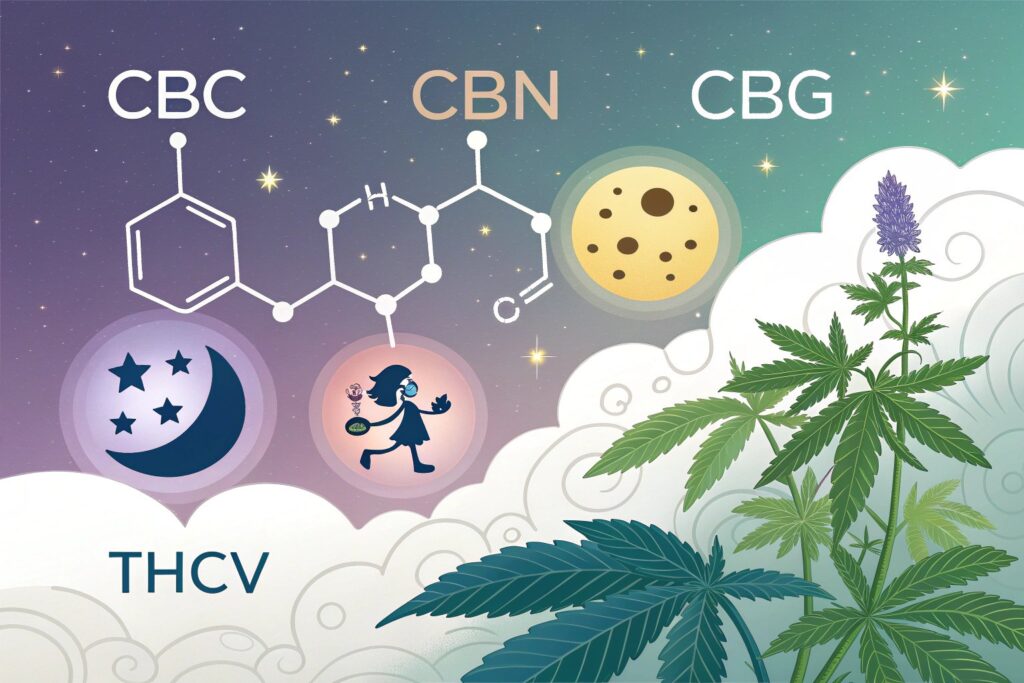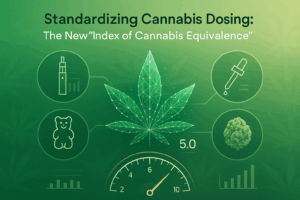Beyond the Bud: Exploring Colombia’s R&D in Rare Cannabinoids
There’s more to cannabis than THC and CBD—and Colombia is proving it. As global demand shifts toward precision medicine and functional wellness, rare cannabinoids like CBG, THCV, and CBC are stepping into the spotlight. And guess who’s leading the charge in this cannabinoid evolution? Colombian producers, with their ideal climate, advanced genetics, and growing investments in R&D. From lush greenhouses to high-tech labs, Colombia is quickly becoming a hub for innovation beyond the bud—and buyers are starting to pay attention. Let’s dive into how Colombia is unlocking the next wave of cannabis potential.
🔹 What Are Rare Cannabinoids and Why Do They Matter?
(Move over THC and CBD—there’s a whole new cast of cannabis compounds coming to the stage.)
If you’re used to seeing only THC and CBD on cannabis labels, get ready for a twist in the story—rare cannabinoids are stepping into the spotlight. These lesser-known compounds may not get all the glory yet, but they could be the real stars of next-generation medicinal cannabis.
From CBG to THCV, these cannabinoids are showing promising potential in everything from inflammation and metabolism to focus and pain relief. And here’s the kicker: Colombia is already growing them.
Let’s explore what rare cannabinoids are, why they matter, and how they’re changing the way serious buyers think about cannabis.
1. More Than Just THC and CBD: Meet the Rare Cannabinoids
We all know THC gets you high and CBD helps you chill. But what about CBG, CBC, CBN, and THCV? These are the so-called minor cannabinoids—but there’s nothing minor about their potential.
Here’s a quick intro to the rising stars:
🌿 CBG (Cannabigerol) – Known as the “mother of all cannabinoids,” it’s non-psychoactive and being studied for gut health and inflammation.
🌿 THCV (Tetrahydrocannabivarin) – This one’s making waves for possible appetite suppression and energy-boosting effects—hello, wellness market!
🌿 CBC (Cannabichromene) – Less studied, but linked to mood and neurogenesis (that’s brain cell growth, folks).
🌿 CBN (Cannabinol) – Often found in aged flower, it’s mildly psychoactive and researched for sleep support and pain management.
These cannabinoids occur in small amounts naturally, which is why they’re called “rare.” But don’t let that label fool you—they may just be the future of medical cannabis formulations.
2. Why Rare Cannabinoids Are Gaining Attention
So, why the buzz now? Simple—precision medicine is on the rise. More patients and providers want cannabis that can target specific conditions, not just “make you feel better.”
Rare cannabinoids offer that kind of specialization. Instead of giving someone high-THC flower and hoping for the best, you can formulate products tailored to a use case—whether it’s anxiety, energy, inflammation, or insomnia.
For buyers, that means:
✅ More differentiated products in a crowded market
✅ Scientific appeal for medical professionals
✅ A story worth telling in marketing and sales decks
Plus, as regulations tighten and more countries embrace cannabis as medicine, having products with unique cannabinoid profiles isn’t just smart—it’s necessary.
3. How Colombia is Growing What’s Next
Now here’s where Colombia enters the chat—not just as a cultivator, but as an innovator. Thanks to ideal growing conditions, diverse genetics, and a sharp focus on research and development, Colombian producers are leading the charge on rare cannabinoids.
What’s making it possible:
🌞 Sun-grown cannabis + controlled conditions = large, healthy yields of diverse plants
🔬 In-house and partner labs doing advanced cannabinoid testing
🧬 Genetic breeding programs aimed at rare cannabinoid expression
📦 Export-ready documentation to match buyer expectations in Europe, Australia, and beyond
Some Colombian growers are already producing flower and extracts with higher CBG and THCV content, and others are testing custom strains designed for consistent minor cannabinoid output.
If you’re a buyer, that means you don’t have to wait for the future—you can source these compounds now, and start building a product line that stands out.
Final Thoughts: The Future Is Rare (And It’s Already Growing in Colombia)
Rare cannabinoids aren’t a trend—they’re the next evolution of cannabis. Whether you’re a formulator, a medical distributor, or a brand builder, these compounds offer new pathways to growth, differentiation, and patient care.
And if you’re looking for a partner that can deliver? Colombia’s producers are combining natural advantages, advanced genetics, and global compliance standards to bring these rare gems to market—affordably and at scale.
So next time you’re reading a COA, don’t stop at THC and CBD. Look for those lesser-known acronyms—they just might be your next big selling point.
🌿 Have you worked with rare cannabinoids yet? Curious about sourcing them from Colombia? Drop your thoughts below!
🔹 CBG, THCV, and Others Making Headlines
(These “minor” cannabinoids are getting major attention—and for good reason.)

If you think cannabis is all about THC and CBD, it’s time for a reality check. Because lately, the spotlight has started to shift to some of cannabis’ lesser-known stars—rare cannabinoids like CBG, THCV, CBC, and more.
These compounds may only appear in small amounts, but they’re creating big waves in medical research, product development, and international sourcing conversations. And guess what? Colombian growers are already ahead of the game, cultivating genetics rich in these cannabinoids and preparing them for export.
Let’s take a closer look at why CBG, THCV, and others are suddenly everywhere—and what they could mean for your business.
1. CBG: The “Mother Cannabinoid” with Medical Promise
CBG—short for Cannabigerol—is called the “mother of all cannabinoids” because it’s the precursor to THC, CBD, and many others. Without CBG, the rest don’t exist. But it’s more than just a backstage player.
CBG is non-psychoactive and is currently being studied for:
🔹 Anti-inflammatory effects (especially in inflammatory bowel disease)
🔹 Neuroprotective potential (possibly beneficial in diseases like Huntington’s)
🔹 Antibacterial properties, especially against resistant strains like MRSA
Why does it matter to you as a buyer or distributor? Because CBG-rich flower and oil offer a new type of product for people who want relief without the THC buzz—and it’s catching the attention of pharmaceutical buyers and wellness brands alike.
🎯 Colombian producers are now selectively breeding strains with higher CBG content, giving them a clear edge in the rare cannabinoid race.
2. THCV: The “Skinny Cannabinoid” with Big Market Appeal
THCV—Tetrahydrocannabivarin—has been called the “sports car of cannabinoids.” Why? Because it’s been linked to appetite suppression, alertness, and potential weight management benefits.
It’s showing potential in:
🧠 Focus and energy support (some users report mental clarity)
🔥 Metabolic health and blood sugar regulation
🍽️ Appetite control, which could interest the wellness and fitness markets
THCV is mildly psychoactive at higher doses, but in small doses, it behaves very differently from THC. It’s becoming a hot ingredient for brands looking to differentiate themselves in a crowded market, especially in non-flower formats like vapes, oils, or softgels.
🌱 In Colombia, the genetics game is strong. Some cultivators are now developing stable THCV-dominant strains for medical export, helping suppliers stay one step ahead of global demand.
3. CBC, CBN, and the Rise of the Supporting Cast
CBG and THCV may be the headliners right now, but don’t sleep on the rest of the rare cannabinoid family.
🔹 CBC (Cannabichromene) is being explored for anti-inflammatory and mood-boosting properties, possibly working in synergy with CBD.
🔹 CBN (Cannabinol) is gaining popularity in sleep-focused products. It’s mildly psychoactive and shows calming, sedative effects when combined with other cannabinoids.
🔹 Even CBDV (Cannabidivarin) is starting to appear in epilepsy research and neurodevelopmental disorder trials.
Each of these cannabinoids offers a new formulation opportunity—especially for buyers looking to go beyond basic THC/CBD combos.
🧪 Colombian labs and producers are already cataloging the full spectrum of cannabinoids in their cultivars, giving you more data, more options, and more product potential.
Final Thoughts: Rare Cannabinoids, Real Opportunity
Rare cannabinoids aren’t just for nerdy scientists or niche product lines—they’re quickly becoming the future of competitive cannabis. Whether you’re supplying pharmacies, wellness brands, or research-driven customers, cannabinoids like CBG and THCV offer exciting new value propositions.
And if you want to get ahead of the curve, look to Colombia. With cutting-edge genetics, consistent lab support, and export-ready facilities, Colombian producers are in a strong position to deliver rare cannabinoid products at scale—and at a price point buyers can love.
🌿 Curious about adding CBG or THCV-rich flower to your offerings? Already experimenting with rare cannabinoids? Let’s talk cannabinoids in the comments!
🔹 Colombia’s Role in Cannabinoid Innovation
(More than just a great place to grow—Colombia is becoming a hotbed for serious cannabis research and rare cannabinoid discovery.)
When people think of Colombia and cannabis, they often picture sunny farms and affordable production. That’s not wrong—but there’s a lot more going on than just growing flower. In fact, Colombia is quietly becoming one of the most innovative countries in the world when it comes to cannabinoid research, rare genetics, and advanced formulations.
From cutting-edge labs to custom-bred strains, Colombian cannabis producers are investing in the next generation of cannabinoid science—and global buyers are starting to notice.
Let’s take a closer look at why Colombia is punching above its weight in cannabis innovation, and what it means for the future of the industry.
1. A Perfect Playground for Plant Research
Colombia offers something most other countries can’t—year-round sunlight, multiple growing seasons, and incredibly diverse microclimates. This makes it the perfect testing ground for new cultivars, especially those designed to produce higher levels of rare cannabinoids like CBG, THCV, and CBC.
Producers in Colombia aren’t just planting what’s trendy—they’re running trials, collecting data, and experimenting with genetics. By rotating crops more frequently, they can test, tweak, and improve faster than competitors in seasonal markets.
🌿 Want a CBG-rich cultivar? Colombia can grow it.
🌿 Need consistent terpene expression? They can dial it in.
🌿 Looking to explore new ratios of cannabinoids? Colombia’s already on it.
All of this is backed by lab testing, phenotyping, and increasing collaboration with universities and biotech partners—creating a research-driven environment where innovation thrives.
2. Breeding Programs That Actually Breed Results
Innovation in cannabis doesn’t just happen in the lab—it starts in the seed. Colombian producers are now investing in selective breeding programs to create plants that are optimized not for high THC, but for minor cannabinoids and therapeutic profiles.
These programs focus on:
🌱 Stabilizing high-CBG or high-THCV strains
🌱 Reducing variability in cannabinoid and terpene expression
🌱 Improving resistance to disease, mold, and pests
🌱 Supporting specific medical use cases through custom cultivars
And the best part? Because of Colombia’s regulatory framework and agricultural know-how, these programs aren’t limited to big companies. Even mid-sized growers are collaborating with breeders to develop exclusive cultivars for export.
✅ For buyers, this means access to unique, high-quality products that stand out in a crowded global market.
3. Labs, Data, and a Focus on Formulation
Colombia’s cannabis industry is no longer just about bulk flower. The shift toward value-added products and pharmaceutical formulations is already happening, and it’s being powered by data-rich testing labs and advanced processing facilities.
Here’s what’s changing:
🧪 Labs are testing beyond THC and CBD—measuring full cannabinoid and terpene profiles with precision.
🧬 Extractors are separating and isolating rare cannabinoids for specific formulations.
📊 Processors are working with healthcare professionals to develop targeted, dose-consistent medical products.
This shift toward innovation is supported by a business culture that values documentation, consistency, and scientific integrity—a huge plus for European buyers who need traceability from seed to shelf.
And yes, many of these labs are either already GMP-certified or on the path—meaning Colombian innovation is ready for regulated medical markets around the world.
Final Thoughts: Colombia is More Than a Grower—It’s a Creator
It’s easy to talk about low-cost production and great climate. But if you’re serious about the future of cannabis, you need more than sunshine—you need R&D, rare genetics, and a commitment to innovation.
Colombia delivers all three.
With world-class breeding programs, deep scientific partnerships, and a culture of quality, Colombia is moving from “affordable source” to global cannabinoid innovation leader. And for buyers, distributors, and product developers, that means new possibilities, new formulations, and new market potential—without the price tag of legacy markets.
🌎 Looking to source innovation—not just inventory? Colombia is already growing what’s next. Let’s talk cannabinoids, R&D, and rare genetics!
🔹 What B2B Buyers Should Know Before Sourcing
(Because the biggest risks in cannabis sourcing don’t show up on a spreadsheet—until it’s too late.)
Let’s be honest—sourcing cannabis for international markets can feel like navigating a jungle with a blindfold on. One moment, everything sounds great: “We have the best flower,” “Our COAs are perfect,” and “Delivery? No problem!” And then reality hits: missed deadlines, questionable paperwork, and product that doesn’t match the pitch.
Whether you’re buying flower, oil, or rare cannabinoids like CBG or THCV, you need more than buzzwords and pretty pictures. You need clear expectations, real documentation, and a partner who delivers—literally and figuratively. So before you send that deposit or sign that purchase order, let’s cover what you really need to know to avoid a cannabis sourcing headache.
1. Ask for the COA—Before You Even Talk Price
Price always matters in B2B deals, but purity and compliance come first. If your product doesn’t pass testing, you lose time, money, and trust.
Before you even negotiate price or shipping, ask for a Certificate of Analysis (COA) from an accredited third-party lab. Not just THC and CBD—but full cannabinoid profiles, terpene content, microbial results, heavy metals, and pesticide screenings.
🔎 Here’s what to look for:
✅ Lab contact details—not just a fancy logo
✅ Batch number that matches the product
✅ Testing date within the last few weeks
✅ PASS status for all safety categories
And if you’re sourcing from Colombia? Great news—many producers there are now offering EU-GMP or GACP-level COAs, ready for Europe, Australia, and beyond.
2. Understand What You’re Really Getting
Not all “high-THCV flower” is created equal. Not all oils are pharma-grade. And not all suppliers are honest about what they can provide.
That’s why you need to ask specific questions like:
📦 “Is this THC-free, full spectrum, or broad spectrum?”
🧪 “How is the product extracted or processed?”
📍 “Where is this grown, and under what standards?”
📋 “Can I see your cultivation/export licenses and SOPs?”
Sourcing cannabis isn’t just about what’s in the bag—it’s about how it got there, and whether it meets the needs of your target market.
🧠 Colombian suppliers have a leg up here. With transparent documentation, standardized processes, and multi-lingual teams, they make it easier to verify what you’re actually buying.




